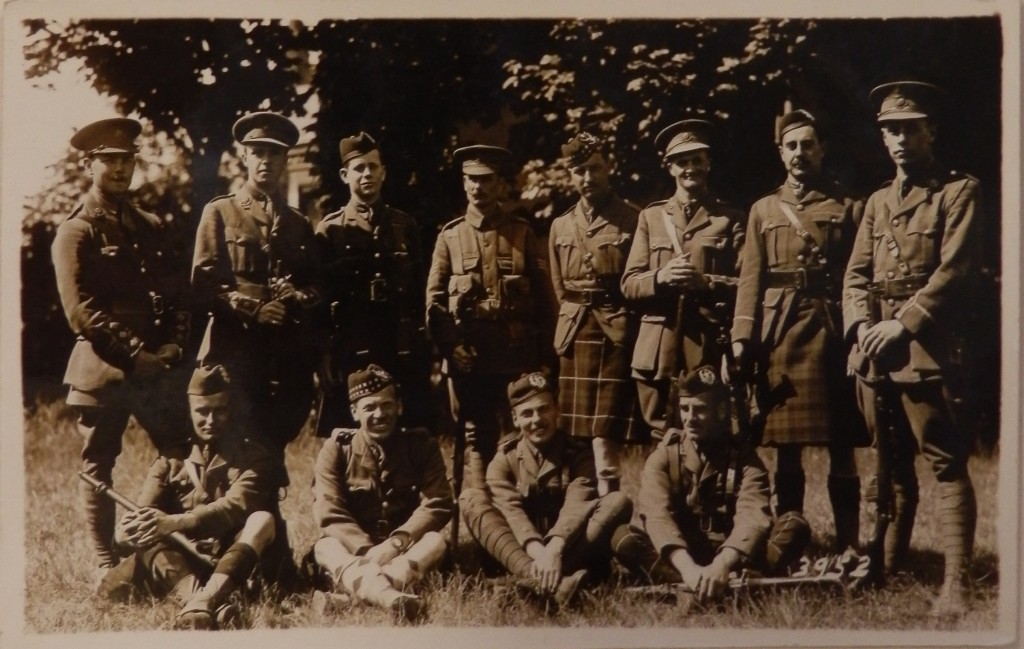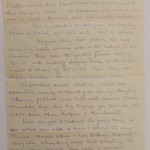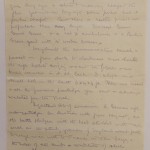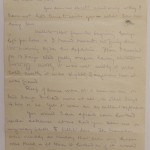
In this letter David Barrogill Keith writes to his family in Thurso describing his first impressions of life in the trenches. As the letter is a long one it has been divided into two parts: this first part describes his advance up the line; the second part, which will be published tomorrow, tells the story of his encounter with the enemy.
To begin with he recounts the march up to the firing line through the ruined town of Vermelles (“about the size of Thurso”) and describes French boys aged 12-15 digging drainage ditches: “wee kids with serious faces & muddy legs dig dig digging”, for all the able-bodied men were on active service. It concludes with him and his men of A Company in the communications trench, ready to advance.
Dated: 4 November 1915, 10th Cameronians, B.E.F.
You are no doubt wondering why I have not had time to write you & what has been doing here.
Well to start from the beginning George left for home & I turned towards the firing line the morning after his departure. There I roosted for 12 days clad fully & never having clothes or boots off. Mostly it was wet, mostly it was cold, mostly it was slightly dangerous but it was grand.
Sleep of course was at a minimum on two days I had none at all on other days 4 hours or so. Yet it was an excellent experience.
 You would I am afraid have looked rather askance at me had you seen me on my way back to billets here. The trenches were muddy, so muddy that even my knees were thick & at times it looked as if it would require some effort other than mine own to pull my huge feet out of the treakly toffee mess.
You would I am afraid have looked rather askance at me had you seen me on my way back to billets here. The trenches were muddy, so muddy that even my knees were thick & at times it looked as if it would require some effort other than mine own to pull my huge feet out of the treakly toffee mess.
However at length we saw daylight – toddled over the open ground & it rained! By evening – we were still toddling – we splashed quite contendedly thro’ two feet of water with light hearts but wet clothes & chilled stomachs.
 But when we got back we had some feed! I rather wished that I could have been photographed there tramping back in the darkness over what was once a road tho’ now thro’ ruts mostly a ditch.
But when we got back we had some feed! I rather wished that I could have been photographed there tramping back in the darkness over what was once a road tho’ now thro’ ruts mostly a ditch.
Tho’ I intended to start from the beginning I have evidently got to the end. But to return.
The first thing that gave me the real sense of a nation at war was on the march to the trenches. There was the youth of France, lads of 12-15 with coats off digging holes at the roadside to drain off the water. There they were digging trenches. It is a marvellous war!
Comparatively small children whom one accustoms oneself to of think as always laughing & playing football, wee kids with serious faces & muddy legs dig dig digging, for the war had made even them helpers of their country.
Well we got to behind the firing line, to see what was once a town – about the size of Thurso. Houses clean & new looking but only irregular chunks of wall left standing. In the gardens behind open gates & painted railings were pear & apple trees, with foliage but no fruit. The fruit no doubt unripe enough in its early youth had been plucked by a hungry Tommy to the RAMC’s [Royal Army Medical Corps] disgust. The church was still standing only half the tower was not, the door was open but I question if any had entered it for months. The Crucifix was visible thro’ the open door. The windows were gone long ago & stones & masonry heaped the floor. Yet not so long ago some priest had it for his chapel. But there is neither priest nor populace there any longer. Instead Guns Guns Guns and a Red X ambulance & a British graveyard with its wooden crosses.
We got into the communication trench & passed on from dusk to darkness & we heard the rifle bullets singing & saw the flares & we knew we were in it at last. I slept in a small hole in the earth 6 x 4 x 4 ft. There we messed & ate the grouse & partridge you sent & always watched for the Bosch.
I gathered lots of souvenirs. A German rifle with cartridges. An Austrian with fixed bayonet. An old battle bludgeon with its head studded with nails such as the sturdy yeomen of England went forth to wage war with to France in other days, & the noses of all kinds & conditions of shells.
These I left. To carry what one needs is bad enough, to carry these also impossible.
After a day or two we transferred nearer the firing line – now about 100 yards from the Bosch…
The next day DB Keith went up to the firing line, and there encountered the enemy for the first time. To be continued tomorrow…
[Caithness Archive Centre reference P38/10/11; part 2 of this letter from DB Keith will be published tomorrow, 5 November.]

